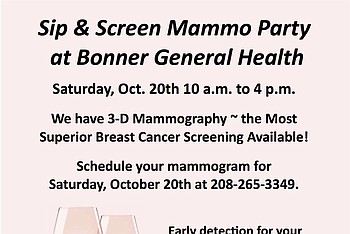Calculating your risk of breast cancer
Bonner County Daily Bee | UPDATED 5 years, 5 months AGO
If your primary care provider has told you that it’s time for you to have a mammogram and you aren’t already signed up for the “sold out” Sip and Screen Mammo Party for October 5, I have good news for you. Thanks to a great response, another party has been scheduled for Saturday, October 26.
You definitely want to make that appointment today. Call 208-265-3349 or go online to www.bonnergeneral.org/mammoparty/. Bonner General Health has 3-D mammography, the latest technology in breast cancer screening. There will be refreshments and prizes and, believe me, lots of fun along with getting a screening for early detection of a dreadful disease.
A personal history of breast cancer or a high-risk lesion are the top factors of an increased risk of (recurring) breast cancer, according to the American College of Physicians. ACP also points out that genetic factors, such as the BRCA1 or BRCA2 gene mutation and exposure to chest radiation as a child can increase propensity as well. These things we know for sure because there’s medical evidence.
But now, there are studies about risk factors that caught my attention and, of course, made me want to share them with you. These are from a reliable website, Medical News Today.
The first headline read: “Onions and garlic may protect against breast cancer.” Read on and it says that onions, garlic, leeks, chives and other allium genus plants are not only rich in flavor but may help to fend off heart disease, diabetes and cancer.
“In regards to cancer, several studies have specifically explored the links between onion and garlic consumption and the risk of colorectal, stomach and prostate cancers,” MNT says. But, wait you say! We’re talking breast cancer here.
With less research to find the link with breast cancer, researchers led by Gauri Desai, a doctoral candidate in epidemiology at the University at Buffalo, set out to check it out and looked into a population of women in Puerto Rico.
Why Puerto Rico? Because they have lower breast cancer rates than in the mainland U.S. and because a condiment called “sofrito” which is basically onions and garlic is a sauce that’s widely consumed there.
Ad- mittedly this was a small study, but the authors wrote: “Sofrito intake, when examined alone, was inversely associated with breast cancer; for those consuming sofrito more than once per day, there was a 67 percent decrease in risk compared to never consumers.”
Interesting? Here’s another one. MNT headline: “Morning people may have lower breast cancer risk.” This study was originally published in the British Medical Journal and analyzed data gathered from 180,216 women from the UK Biobank and 228,951 women from the Breast Cancer Association Consortium.
Researchers reported that they found “consistent evidence” that people preferring mornings had a lower risk factor for breast cancer.
“They also found ‘suggestive evidence’ that sleeping more than seven to eight hours per night could have an ‘adverse effect’ on breast cancer risk. The researchers emphasize that the effects they found are small, compared with that of other risk factors for breast cancer, such as BMI, alcohol consumption, and smoking.”
And, as you get to the end of the article they state “…data showed that women with a morning preference had a less than 1 percent lower risk of breast cancer compared with women with an evening preference.” So, that’s a bust, isn’t it?
More important than adding onions to your early morning smoothie, is to know the signs of breast cancer. Besides lumps in the breast or under the arm, other signs include changes in breast size and shape; pain in a specific area that doesn’t go away; prominent veins on the surface of the breast; nipple discharge that starts suddenly; a sore or rash on the nipple; swelling, redness, or darkening of the breast; dimpling of the skin on the breast; inversion of the nipple or other parts of the breast.
These symptoms don’t necessarily mean that you have cancer. Some of these changes are often linked to benign breast issues, but don’t self-diagnose. See your primary care provider if any of these changes occur. And, don’t forget to call to make your appointment for the Sip and Screen Mammo Party!
Kathy Hubbard is a member of Bonner General Health Foundation Advisory Council. She can be reached at kathyleehubbard@yahoo.com.
MORE IMPORTED STORIES
Reserve your spot for Sip and Screen Mammo Party
Bonner County Daily Bee | Updated 5 years, 6 months ago

